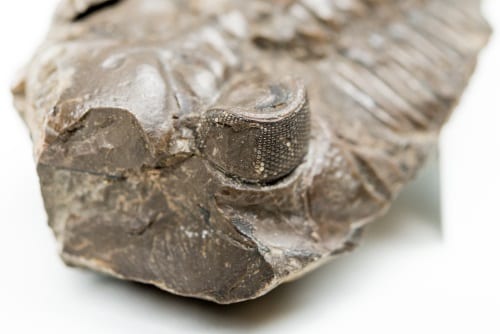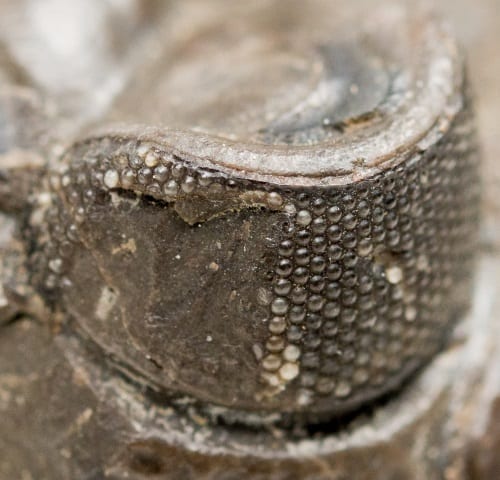Specimen of the Week 270: Dalmanites trilobite
By Tannis Davidson, on 16 December 2016
O trilobite, o trilobite
You must be Dalmanites
O trilobite, o trilobite,
You must be Dalmanites
Your exoskell’s ovoid in outline
Your frontal lobe is vaulted fine
O trilobite, o trilobite
You must be Dalmanites
Eleven thoracic segments
Pleural furrows deeply impressed
O trilobite, o trilobite
You must be Dalmanites*
This week’s Specimen of the Week is a jolly little chap, ready to bring the Christmas cheer to Grant Museum blog readers everywhere. An early gift from Santa’s pack, this fossil has recently arrived at the Grant Museum following a transfer from UCL’s Geology teaching collection. Despite being a bit broken and a bit repaired, this trilobite has received a warm welcome from all who have glanced upon his charming petrified remains. Behold this week’s Specimen of the Week…
**Dalmanites caudatus trilobite**
This trilobite hails from the Silurian period, specifically the Wenlock series dating from 433.4 – 427.4 million years ago. It is named after Wenlock Edge (a limestone escarpment near Much Wenlock in Shropshire, England, and is a lagerstätte site with special scientific interest designation due to its rich fossil beds providing a snapshot of time around 420 million years ago. During this time, this area was a shallow subtropical sea south of the equator, at about the same latitude as the Seychelles is today. As such, these deposits reveal the diversity of life which lived in the shallow marine reef habitat with the fossil fauna including corals, crinoids, brachiopods, ostracods and trilobites.
Trilobites had been around long before the Silurian. They are well-known as being one of the earliest known groups of arthropods first appearing in the fossil record in the Early Cambrian period 521 million years ago. They were a highly diverse group (17,000 known species) with a wide geographical distribution (fossils are found worldwide) which populated the Paleozoic seas for over 270 million years. The last trilobites to go extinct were those in the Proetida order which died out along with 96% of the world’s marine species and 70% of terrestrial vertebrates in the Permian-Triassic extinction event 252 million years ago.
The morphological diversity seen in trilobites hints at their differing lifestyles. Some were able to swim and fed on plankton. Others moved along the sea bed as predators, scavangers or filter feeders. It is thought that most early trilobites were predators which were able to process prey with their expanded gnathobases (a lower appendage of many arthropods used to macerate food) and inflated glabellae (middle part of the head) which housed a expanded digestion chamber 1.
Perhaps the most famous feature developed by trilobites was the appearance of sophisticated visual systems. Most trilobites had compound eyes (made up of many lenses) which were sensitive to motion. Together with an internal doublet structure (two lens layers of different refractive indices) which made possible an exceptional depth of field , trilobite complex eyes would have been essential to detect predators.
O trilobite, o trilobite
Such magnificence you show us
O trilobite, o trilobite
The many lenses of caudatus
Most trilobites had holochroal eyes (up to 15,000 lenses in tessellated hexagons, single corneal membrane). The eye on our specimen is defined as a (less common) schizochroal eye – having (from a few to up to 700) relatively large and thick lenses, each covered by its individual cornea. In schizochroal eyes, each lens is in a conical socket separated from other lenses by the sclera (opaque layer of tissue). This separation continues into the skeletal framework of the eye serving as a suspension for the individual corneas. How these eyes functioned and what exactly was the visual experience is still largely unknown and subject to continued investigation 3.
* Sing to the tune of ‘O Christmas Tree’
Tannis Davidson is the Acting Curator at the Grant Museum of Zoology
References
- Fortey, R.A., & R.M.Owens. 1999. Feeding habits in Trilobites. Palaeontology 42(3):429-65.
- Clarkson, E. N. K. & R. Levi-Setti. 1975. Trilobite eyes and the optics of Des Cartes and Huygens. Nature 254 (1975): 663-667.
- Clarkson, E., Levi-Settib, R., and G.Horváthc. 2006. The eyes of trilobites: The oldest preserved visual system. Arthropod Structure & Development Volume 35, Issue 4, December 2006, Pages 247–259.
 Close
Close




